Abstract
The administration of tungsten to rats maintained on a low molybdenum diet resulted in a dose- and time-dependent loss of sulfite oxidase (EC 1.8.3.1) and xanthine oxidase (EC 1.2.3.2) activities and hepatic molybdenum. These tungsten-treated animals appeared healthy, but were more susceptible to bisulfite toxicity. The median lethal dose for intraperitoneal bisulfite was found to be 181 mg of NaHSO3 per kg for the animals deficient in sulfite oxidase, compared to 473 mg/kg for normal rats.
The survival time of rats exposed to SO2 at concentrations of 590 ppm and higher was seen to be inversely related to the level of SO2. At 590 ppm and 925 ppm, control animals displayed symptoms of severe respiratory toxicity before death. At 2350 ppm of SO2, death was preceded by seizures and prostration, symptoms observed with the systemic toxicity of injected bisulfite. At 590 ppm, animals deficient in sulfite oxidase were indistinguishable from control animals. However, at 925 ppm and 2350 ppm, the deficient animals displayed symptoms of systemic toxicity and had much shorter survival times. It is concluded that sulfite oxidase is instrumental in counteracting the toxic systemic effects of bisulfite, either injected or derived from respired SO2. Respiratory death probably results from the toxicity of gaseous SO2 before absorption as bisulfite and cannot be alleviated by sulfite oxidase. Sulfite oxidase does not appear to be inducible by either bisulfite or SO2.
Keywords: rat, tungsten, molybdenum deficiency, systemic and respiratory toxicity, enzyme induction
Full text
PDF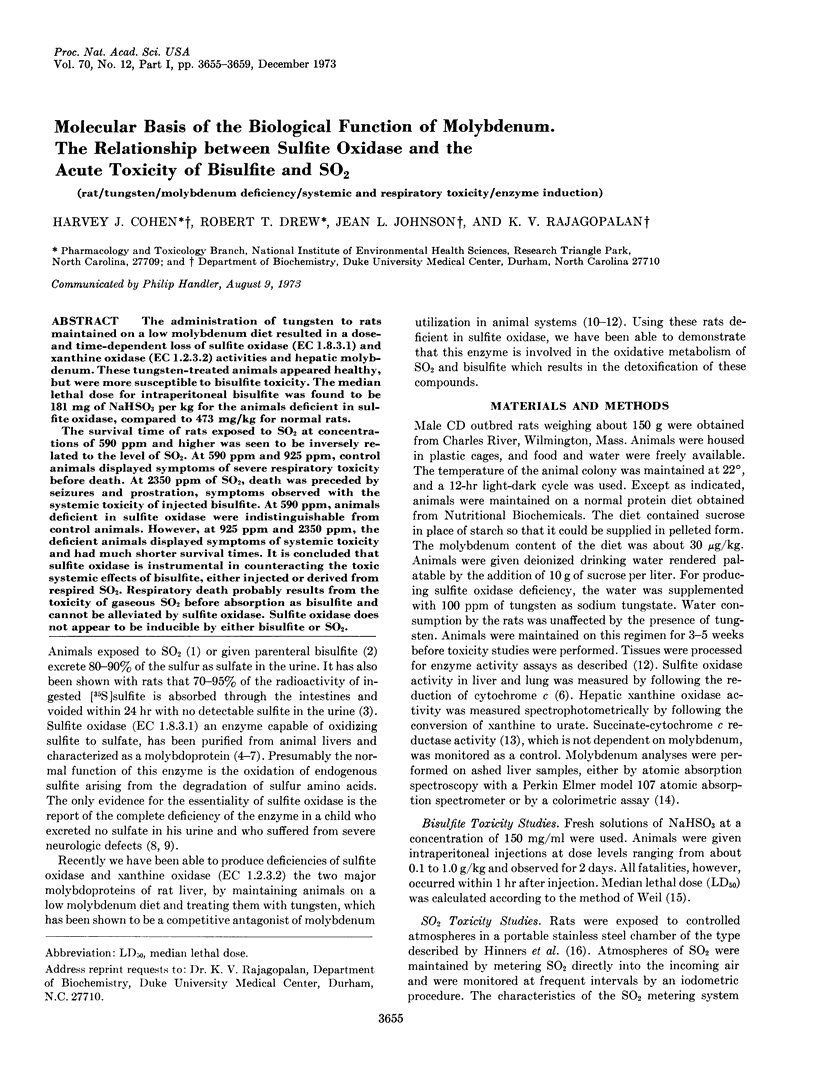
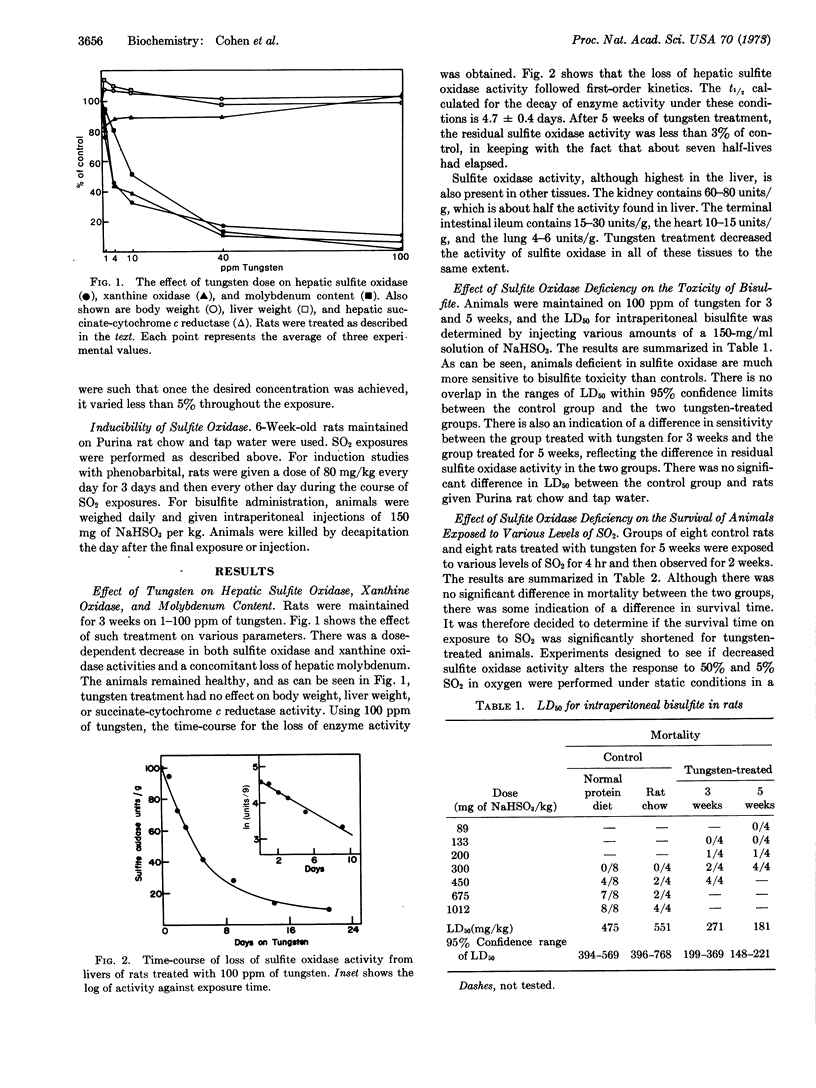
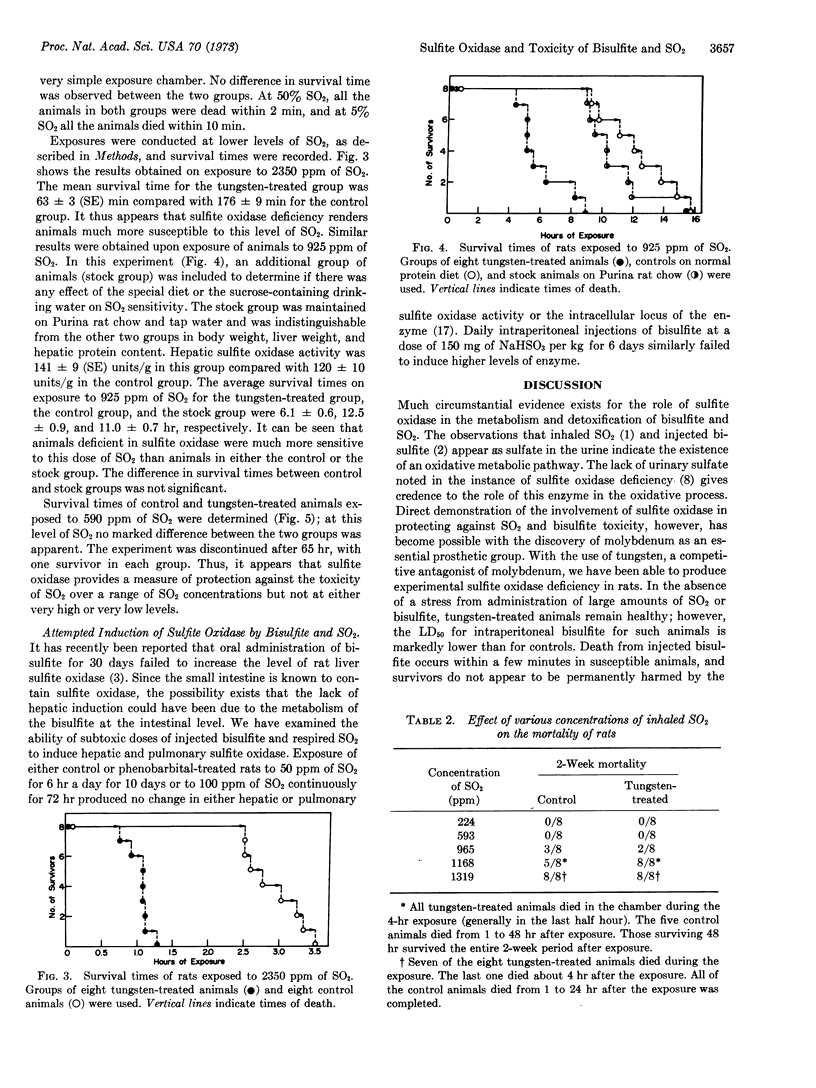
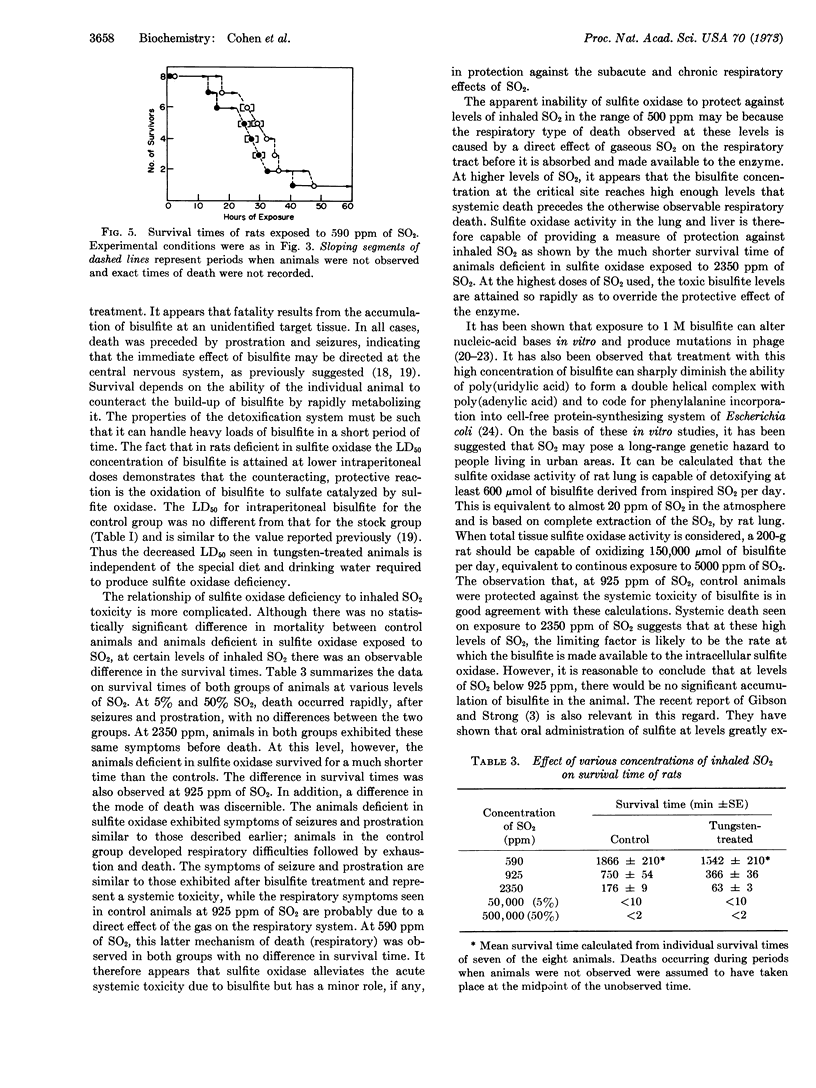
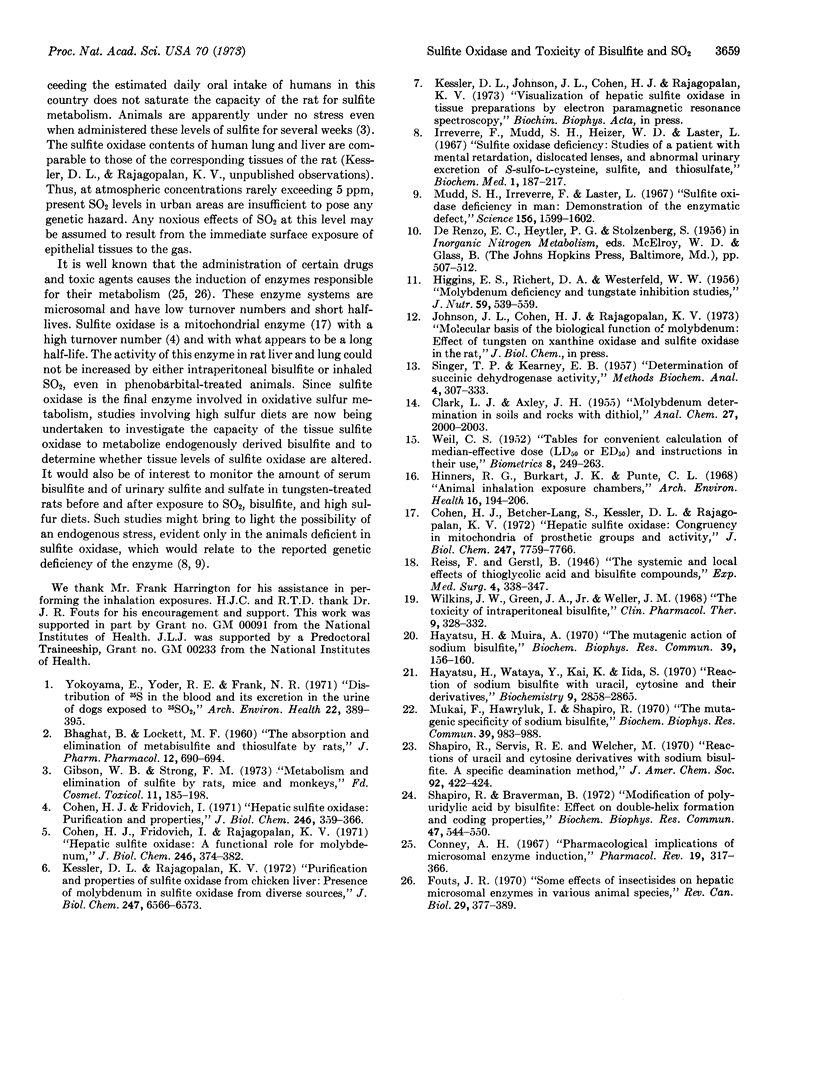
Selected References
These references are in PubMed. This may not be the complete list of references from this article.
- Cohen H. J., Betcher-Lange S., Kessler D. L., Rajagopalan K. V. Hepatic sulfite oxidase. Congruency in mitochondria of prosthetic groups and activity. J Biol Chem. 1972 Dec 10;247(23):7759–7766. [PubMed] [Google Scholar]
- Cohen H. J., Fridovich I. Hepatic sulfite oxidase. Purification and properties. J Biol Chem. 1971 Jan 25;246(2):359–366. [PubMed] [Google Scholar]
- Cohen H. J., Fridovich I., Rajagopalan K. V. Hepatic sulfite oxidase. A functional role for molybdenum. J Biol Chem. 1971 Jan 25;246(2):374–382. [PubMed] [Google Scholar]
- Conney A. H. Pharmacological implications of microsomal enzyme induction. Pharmacol Rev. 1967 Sep;19(3):317–366. [PubMed] [Google Scholar]
- Fouts J. R. Some effects of insecticides on hepatic microsomal enzymes in various animal species. Rev Can Biol. 1970 Dec;29(4):377–389. [PubMed] [Google Scholar]
- Gibson W. B., Strong F. M. Metabolism and elimination of sulphite by rats, mice and nonkeys. Food Cosmet Toxicol. 1973 Apr;11(2):185–198. doi: 10.1016/s0015-6264(73)80485-7. [DOI] [PubMed] [Google Scholar]
- HIGGINS E. S., RICHERT D. A., WESTERFELD W. W. Molybdenum deficiency and tungstate inhibition studies. J Nutr. 1956 Aug 10;59(4):539–559. doi: 10.1093/jn/59.4.539. [DOI] [PubMed] [Google Scholar]
- Hayatsu H., Miura A. The mutagenic action of sodium bisulfite. Biochem Biophys Res Commun. 1970 Apr 8;39(1):156–160. doi: 10.1016/0006-291x(70)90771-0. [DOI] [PubMed] [Google Scholar]
- Hayatsu H., Wataya Y., Kai K., Iida S. Reaction of sodium bisulfite with uracil, cytosine, and their derivatives. Biochemistry. 1970 Jul 7;9(14):2858–2865. doi: 10.1021/bi00816a016. [DOI] [PubMed] [Google Scholar]
- Hinners R. G., Burkart J. K., Punte C. L. Animal inhalation exposure chambers. Arch Environ Health. 1968 Feb;16(2):194–206. doi: 10.1080/00039896.1968.10665043. [DOI] [PubMed] [Google Scholar]
- Kessler D. L., Rajagopalan K. V. Purification and properties of sulfite oxidase from chicken liver. Presence of molybdenum in sulfite oxidase from diverse sources. J Biol Chem. 1972 Oct 25;247(20):6566–6573. [PubMed] [Google Scholar]
- Mudd S. H., Irreverre F., Laster L. Sulfite oxidase deficiency in man: demonstration of the enzymatic defect. Science. 1967 Jun 23;156(3782):1599–1602. doi: 10.1126/science.156.3782.1599. [DOI] [PubMed] [Google Scholar]
- Mukai F., Hawryluk I., Shapiro R. The mutagenic specificity of sodium bisulfite. Biochem Biophys Res Commun. 1970 Jun 5;39(5):983–988. doi: 10.1016/0006-291x(70)90421-3. [DOI] [PubMed] [Google Scholar]
- SINGER T. P., KEARNEY E. B. Determination of succinic dehydrogenase activity. Methods Biochem Anal. 1957;4:307–333. doi: 10.1002/9780470110201.ch9. [DOI] [PubMed] [Google Scholar]
- Shapiro R., Braverman B. Modification of polyuridylic acid by bisulfite: effect on double helix formation and coding properties. Biochem Biophys Res Commun. 1972 May 12;47(3):544–550. doi: 10.1016/0006-291x(72)90913-8. [DOI] [PubMed] [Google Scholar]
- Wilkins J. W., Jr, Greene J. A., Jr, Weller J. M. Toxicity of intraperitoneal bisulfite. Clin Pharmacol Ther. 1968 May-Jun;9(3):328–332. doi: 10.1002/cpt196893328. [DOI] [PubMed] [Google Scholar]
- Yokoyama E., Yoder R. E., Frank N. R. Distribution of 35S in the blood and its excretion in urine dogs exposed to 35SO2. Arch Environ Health. 1971 Mar;22(3):389–395. doi: 10.1080/00039896.1971.10665861. [DOI] [PubMed] [Google Scholar]


